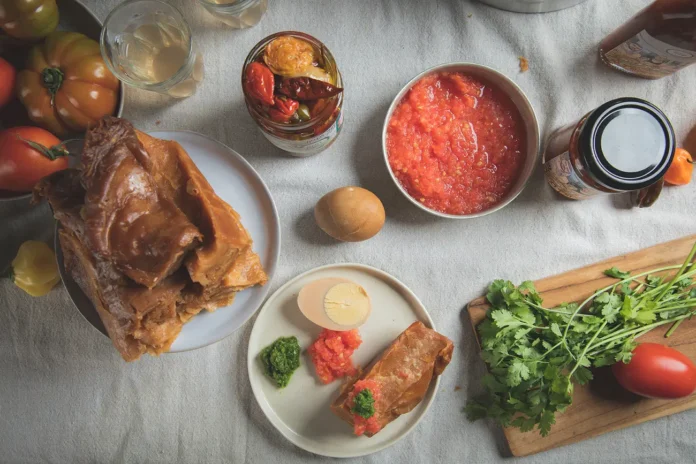For the first time, the Tel Aviv Port Market will honor the king among local pastries: jachnun. The market’s plaza will be crowded with vendors selling fresh, homemade treats for two weekends consecutively–January 19-20 & January 26-27.
Jachnun has been popularized as a Jewish Yemenite dish. However, it is also known for its malawach pastry, which has been a staple in Israeli fast food for decades. Both are perfect comfort foods.
Let’s begin with jachnun. It’s warm and mildly sweet and leaves you feeling fuzzy. Although it could be mistakenly referred to as a dessert, it is actually a Shabbat breakfast dish. It is served with an oven-baked egg and fresh grated tomato.
Jachnun can now be eaten anywhere and anytime. This log-shaped sweetie is a must-have at any Israeli school picnic or hotel breakfast buffet. Some Israelis are making jachnun from scratch, although for years it was only made by Yemenite grandmothers. We would buy it frozen if we wanted to eat it at home. Or, we could order it as takeout.
Jachnun can be found at many cafes and rest stops. On weekends, jachnun can be bought everywhere in Israel. Convenience stores have a container of warm jachnun and kiosks sell jachnun to clubbers after a night out. It’s common to see DIY signs written in felt-tip pen that inform passersby about jachnun stands along the side roads while traveling throughout the country.
Every corner of the globe, Jews have found their own solutions to feeding their families on Shabbat. They also considered religious prohibitions and local resources. Different Yemenite Jews came up with various solutions. Jachnun was the solution for the Jews of Aden, a port city in southern Yemen. This was where the Jewish community thrived until the 1947 pogrom, which ended the community’s existence. Many Adeni Jews were transported to Israel in 1949-50 as part of Operation on Eagles’ Wings, also known as Operation Magic Carpet. The rest were relocated to the U.K. and Aden was completely wiped out by 1967.
Adeni Jews used the jachnun to be cooked at low temperatures overnight. They ate it Saturday after synagogue. It took several days to prepare the dough. It is basically a double-sided folding of the dough, where you brush it with any fat and then fold it over and over to form a laminated layer. The dough is then rolled out and slow-cooked in an oven with a lid. Jachnun is made from whole wheat flour and clarified butter in Aden. The recipe was changed in Israel to white flour and margarine. Some still use margarine, while others use butter or vegan margarine. Israelis add salt and sugar to their dough.
Aden’s port was called “Yemen’s gateway to the globe” by Gil Marks, which helps explain foreign influences on local cuisine. Jachnun is very similar to the Spanish hojaldre puff pastry that Sephardic Jewish exiles may have brought to the Ottoman Empire (according Encyclopedia of Jewish Food to Gil Marks) and to the Turkish duka dough, which Sephardic Jews’ Bourekas are made of.
Original Adeni jachnun, which was different from Israel’s, was pronounced differently and tasted differently. The tomato salsa was also added somewhere along the journey. Yemenite Jews living in other parts of Yemen didn’t taste jachnun until they arrived in Israel. Some people even claim jachnun was invented by Israel, which is something that Adeni Jews strongly deny. Jachnun was first discovered by other Jews from Yemen, who were on their way to Israel.
In the 19th century, Jews began to migrate from Yemen to Palestine. The 20th century saw immigration continue. Since the ruling imam wouldn’t allow Jews to migrate to Israel, they had first to Aden (a British protectorate) and then travel onwards. Yemen closed its doors in May 1945 and refused to allow Jews to leave. This meant that many Jewish families who had left their homes to migrate to Israel were stuck in Aden. The Joint Distribution Committee, an American Jewish relief organization, built Hashed, a refugee camp where thousands of Jews stayed for three years until they were allowed to leave for Israel. Many Yemenite Jews were first to taste jachnun at this camp. According to Moshe David’s book, Disappearing Flavours of the South, this is where many Yemenite Jews learned how to use wheat flour just like the Adeni Jews.
Aden was under British control from 1839 to 1967. Because it was a port city, wheat flour there was more readily available than elsewhere in Yemen. Wheat flour was rare and costly outside Aden so Yemenite Jews used sorghum and millet to make their bread. Independent food researcher Nir Wollman highlighted how important the switch from sorghum flour to wheat flour was at a symbolic level. Wollman said that “In the Arab World, rich people used wheat.” “Wheat was a symbol of power. It was also the most venerated grain in Arab culture. Therefore, those who had enough money to buy wheat were able to bake goods made from other cheaper grains.
Wheat flour was therefore used when it was available and affordable. Pastries were often made with less expensive flour on weekdays, and with wheat on Shabbat. Kubaneh is an example of a Shabbat bread that was made with cheap flour on weekdays and wheat flour for Shabbat.
Many Yemenite Jews emigrated from Yemen to Israel. They were already familiar with wheat and others had started to use it in Israel. The sorghum that they used to bake in Yemen was also used to feed Israeli chickens. It was so that Yemenite cuisine is often associated with Israeli wheat flour pastries. However, most Yemenite Jews don’t use wheat flour from Yemen.
“I know that jachnun originated from Aden but my mother was not from Aden and she used to make jachnun,” I learned from Nava Mazari. She is an expert jachnunmaker and sells jachnun as well as many other Yemenite specialties from zhug, fenugreek, and lahoh from her home in Kfar Yavetz (a moshav) in central Israel. Mazari started the Facebook page Delicacies from the Yemenite Kitchen three years ago. Here she shares her recipes, except for her jachnun recipe which is kept top secret.
Mazari’s parents emigrated from Yemen in 1949. They lived in Yemeni areas close to Sanaa. Her mother was a cook in Israel. Mazari said that she regretted not having written down her mother’s recipes when she was still living. “But I have perfected my recipes over the years to achieve the exact tastes and smells that I recall from her kitchen growing up. Everybody who makes jachnun or malawach, kubaneh or lahoh is unique today. There are so many recipes. We have the ingredients we need now that they didn’t have back in Yemen, or even in the beginning of the country. It’s easier to have the ingredients we do now.
Malawach is definitely the queen of Israeli comfort food, if jachnun is the king. It is easy to stock up on frozen malawach from the supermarket. It is simple and delicious to fry a frozen malawach on a pan.
Malawach’s origins are not as well-known and widely discussed as jachnun. The dough used for malawach is the same as that of jachnun, although the quantities may differ. However, it is pan-fried. Malawach is flat and round, while jachnun is cylindrical-shaped. Malawach, on the other hand, is rich, chewy, sweet, and less greasy than jachnun. It is flaky and golden in colour.
Both are served with a hard-boiled egg and grated tomato in Israel. However, people tend to be more loose about malawach. It can be used flat as a wrap, and many people spread honey, cream cheese or Nutella on top.
The lax attitude to malawach may be due to the Israeli fast-food chain Nargila, which means hookah. This fast-food chain popularized jachnun as a staple in Israel’s 1980s and 1990s. The Nargila chain is known for creating a dish called Ziva, a malawach roll filled with cheese. It was named after the waitress and girlfriend of the owner.
No more Nargila restaurants. The Jahnun Bar in Jerusalem’s Machaneh Yehudah Market is the best place to get the Israeli experience of jachnun and malawach. Yariv Guri and Regev Eibenschutz opened the Jahnun bar on Jerusalem’s Hillel Street 21 year ago. Although neither of them are Yemenites, they shared a passion for malawach and jachnun.
Although the original branch is now closed, their flagship restaurant at Machaneh Yehudah Market remains a popular tourist attraction. Eibenschutz shared a hearty laugh with me, “Some American Jews who visit Israel try to reserve a table months ahead of time, not realizing that this is a street food stand.” Jahnun Bar has also opened a branch in Modi’in. They are currently looking to open more branches in Tel Aviv and Amsterdam to expand their reach to the rest of Europe.
They also offer malawach wraps and jachnun, in addition to the standard jachnun. These wraps can be filled with any combination of cheeses, mushrooms, and even shashshuka. A guide will stop at the market to give you a malawach, which is a steamed pizza-like dish, when you are on a culinary tour.
Jahnun Bar is a lively and noisy place, in an uber Israelii way. When it’s time for the pan to be turned to the other side, they raise the pan high up in front of their stunned eyes. The fried dough disc then performs several somersaults. “This holds no purpose,” Eibenschutz admitted. It’s strictly for entertainment and it is only done in Machaneh Yehudah.
Although jachnuns and malawach have been a fast-food staple since long ago, many Jewish-Yemenite pastries are still not quite there. Most Israelis know at least some of these pastries. If you go a bit deeper, you will find a Yemenite restaurant in Kerem HaTeimanim, Hatikva Quarter-Tel Aviv neighborhoods, where many Yemenites settled, or any other Yemenite areas in the country. You can try saluf (a traditional Yemenite flatbread), lahoh, a sponge-like bread made with a fermented batter and similar to injera (an Ethiopian staple flatbread), Sabaya (crispy Yemeni cake), kubaneh, kubaneh, kubaneh, kubaneh, kubaneh, a , a , a , sa , sa , a , sa , a , a , spy layer cake made from the sabaya sa , kubaneh and more.
Although Jewish-Yemenite food can be varied and include soups, meat, and vegetable dishes, Yemenite cuisine is often used in Israel to refer to pastries. This is something that many descendants of the community resent. They consider it a crime to reduce Jewish-Yemenite cuisines to dough. However, Israelis love pastries that are richer and more suited to Western tastes. They are now sweeter and more nutritious, but they still taste great.















